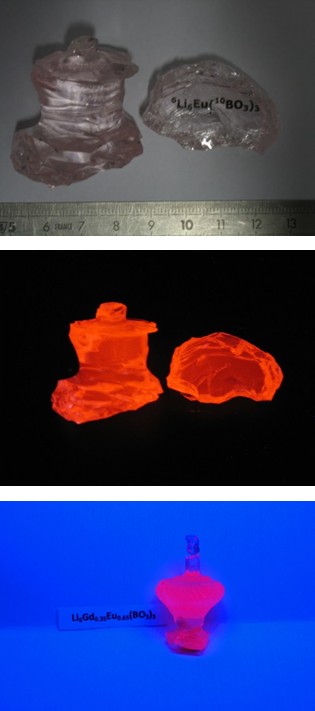| Search for content and authors |
Growth and spectroscopic properties of 6Li- and 10B-enriched crystals for heat-scintillation cryogenic bolometers used in the rare events searches |
| Rekia Belhoucif 1,6, Matias Velazquez 1, Yannick Petit 1, Olivier Pérez 2, Benoît Glorieux 1, Oudomsack Viraphong 1, Pierre de Marcillac 3, Noël Coron 3, Lidia Torres 3,4, Emmanuel Véron 5, AbdelHamid Kellou 6, Philippe Veber 1, Rodolphe Decourt 1, Hassan El Hafid 1 |
|
1. Institut de Chimie de la Matiere Condensée de Bordeaux, ICMCB - CNRS, 87 avenue du Dr Albert Schweitzer, Pessac 33608, France |
| Abstract |
he dark matter content of the Universe accounts for 23% of its total energy [1]. Dark matter particles from the halo of our galaxy can be, in principle, detected by the nuclear recoils that they produce in a detector when scattered off nuclei and great experimental efforts are nowadays dedicated to this subject [2]. In the past decade, improved sensitivity of this kind of experiments has come from the acquired capability of distinguishing nuclear recoils in the detector (like those presumably produced by WIMPs) from electronic recoils (produced by the most common radioactive background—gamma, electrons and alpha particles) [3-6]. Neutrons, which scatter off nuclei, are therefore the ultimate background of these searches. A bolometer consists of a crystal absorber strongly coupled to a thermometer, both weakly coupled to a heat sink maintained at 10-30 mK. When a particle of any kind interacts with the absorber, the energy released is seen as a temperature increase by the sensor. Scintillating bolometers are double readout (light and heat) detectors that measure simultaneously the heat and the light generated by a particle [7]. Particle discrimination is achieved by comparison of both signals, since the heat released by a particle is similar for all types of particles, and proportional to their energy, and the light yield strongly depends on the ionization power of the incident particle [3-7]. In this context, we are developing the growth of crystals with diameters of several centimeters and thicknesses several times the thermal neutron mean free path in 6Li-based crystals and the range of neutron capture induced particles in crystals made of 6Li or 10B, typically 6 mm for alpha’s and 34 mm for tritiums in lithium borates. As the 6Li and 10B isotopes, as well as several Gd isotopes, exhibit high neutron capture cross-sections (sigma10B-n~4sigma6Li-n(10 keV)~8.10-24 cm2) [8,9], it soon turned out that crystals of the Li6Gd(BO3)3-type would constitute ideal candidates for both tailoring HSBCs with high light yields over a wide neutron energy range and adapting them to powerful light detectors working at low temperature and available from UV to X-ray spectral ranges [3-7].
Figure 2. Top : FL-calibrated stimulated emission cross section of 6Li6Eu(10BO3)3 single crystals at room temperature. The inset shows an experimental energy level diagram of Eu3+ ions in 6Li6Eu(10BO3)3 that was cross-checked by a) MKSA magnetic susceptibility meausrements of unoriented 6Li6Eu(10BO3)3 and Li6Eu0.75Gd0.25(BO3)3 single crystals, and b) specific heat measurements of 6Li6Eu(10BO3)3 and Li6Eu0.75Gd0.25(BO3)3 single crystals and of a Li6Gd(BO3)3 sintered pellet. Moreover, in contrast with the 6LiF bulk crystals which we recently developed, 6Li6(Eu,Gd)(10BO3)3 crystals are much less likely to exhibit thermoluminescence properties detrimental to HSCB applications [10]. In this work, we present the crystal growth by combined Czochralski and Kyropoulos methods, initiated on specifically oriented seeds, of centimeter-sized 6Li6Eu(10BO3)3 and Li6(Eu,Gd)(BO3)3 single crystals with an heretofore unexplored concentration range for HSBCs application. The crystal structure and lattice thermal expansion of the former, obtained for the first time by single crystal X-ray diffraction (XRD), and the spectroscopic characterizations together with a consistent set of related thermodynamical properties measurements (magnetic susceptibility, specific heat), also unknown to date, are discussed. Finally, preliminary scintillation measurements at low temperature between 300 and 1100 nm under X-ray excitation are shown. 1 N. Jarosik et al., The Astrophysical Journal Suppl. Ser., 2011, 192:14, 15 pp. 2 J. Beringer et al. (Particle Data Group), Phys. Rev. D 86 010001 (2012) 289-296. 3 P. de Marcillac, N. Coron, G. Dambier, J. Leblanc, J.-P. Moalic, Nature, 2003, 422, 876-878. 4 N. Coron, P. de Marcillac, J. Leblanc, G. Dambier, J.-P. Moalic, Opt. Eng., 2004, 43 (7), 1568-1576. 5 A. Calleja, N. Coron, E. Garcia, J. Gironnet, J. Leblanc, P. de Marcillac, M. Martinez, Y. Ortigoza, A. Ortiz de Solorzano, C. Pobes, J. Puimedon, T. Redon, M. L. Sarsa, L. Torres, J. A. Villar, J. Low Temp. Phys., 2008, 151, 848-853. 6 G. Angloher et al., Eur. Phys. J. C, (2012), 72:1971, 22 pp. 7 H. Kraus et al., 2010, PoS(IDM2010) 109. 8 M. Knitel, In New inorganic scintillators and storage phosphors for detection of thermal neutrons, PhD thesis, Delft University of Technology, 1998. 9 G. F. Knoll, In Radiation detection and measurement, 4th edition, John Wiley & Sons (Ed.), 2010, chapters 14 & 15. 10. M. Martinez, N. Coron, C. Ginestra, J. Gironnet, V. Gressier, J. Leblanc, P. de Marcillac, T. Redon, P. Di Stefano, L. Torres, P. Veber, M. Velazquez and O. Viraphong, J. Phys. : Conf. Ser., 2012, 375, 012025/1-4. |
| Legal notice |
|
| Related papers |
Presentation: Oral at 17th International Conference on Crystal Growth and Epitaxy - ICCGE-17, General Session 2, by Matias VelazquezSee On-line Journal of 17th International Conference on Crystal Growth and Epitaxy - ICCGE-17 Submitted: 2013-03-13 15:10 Revised: 2013-07-28 00:17 |